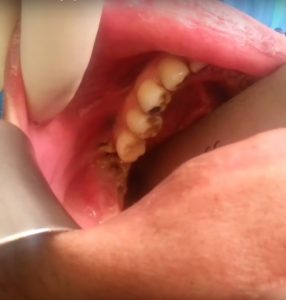 Low dose bisphosphonates are responsible for half the cases of osteonecrosis of the jaw seen by oral surgeons, and the number of patients affected is rising, figures from Queensland show.
Low dose bisphosphonates are responsible for half the cases of osteonecrosis of the jaw seen by oral surgeons, and the number of patients affected is rising, figures from Queensland show.
An audit of three Queensland public hospital found that 32 of the 61 patients admitted with the condition between 2003 and 2015 had been using low dose bisphosphonates, mostly for osteoporosis, but including three for rheumatoid arthritis and two for Paget’s disease.
Rates of osteonecrosis of the jaw had increased steadily, reaching around 10 admissions per year due to bisphosphonates by 2015, the review, published in Australian Dental Journal showed.
It found the other cases of medication-related osteonecrosis were seen in patients taking high dose bisphosphonates for multiple myeloma (25% of cases), breast cancer 12%) or prostate cancer (10%).
A further 160 cases of radiation-related osteonecrosis were seen at the three hospitals among patients undergoing radiation treatment for head and neck cancers.
Patients who developed medication-related osteonecrosis of the jaw were more likely to be female (59%) and had an average age of 67. They required an average length of hospital stay of three days for osteonecrosis.
The authors of the review said it showed osteonecrosis of the jaw was not confined to high dose bisphosphonate therapy used in oncology settings, but was also seen in osteoporosis treatment.
“Although the overall prevalence of medication-related osteonecrosis of the jaw in this patient group is low, this still translates into a substantial burden of disease due to the high number of patients treated for osteoporosis,” they wrote.
They also remarked that the cases seen were likely at the more severe end of the spectrum, requiring treatment, and therefore the figures may have underestimated the true incidence of medication-relation osteonecrosis of the jaw in the community.
“This is an important finding … [it suggests] the number of osteoporosis patients affected by medication-related osteonecrosis of the jaw should not be underestimated,” they added.
The findings showed the need for optimum oral care for all patients receiving bisphosphonates, they suggested, especially when there were financial or access barriers to dental care.
“The findings of this study suggest that despite a considerable body of evidence reporting the efficacy of preventative measures in the reduction of both [radiation-related osteonecrosis] and medication-related osteonecrosis of the jaw, this has not translated into a reduced number of patients presenting with these treatment complications.